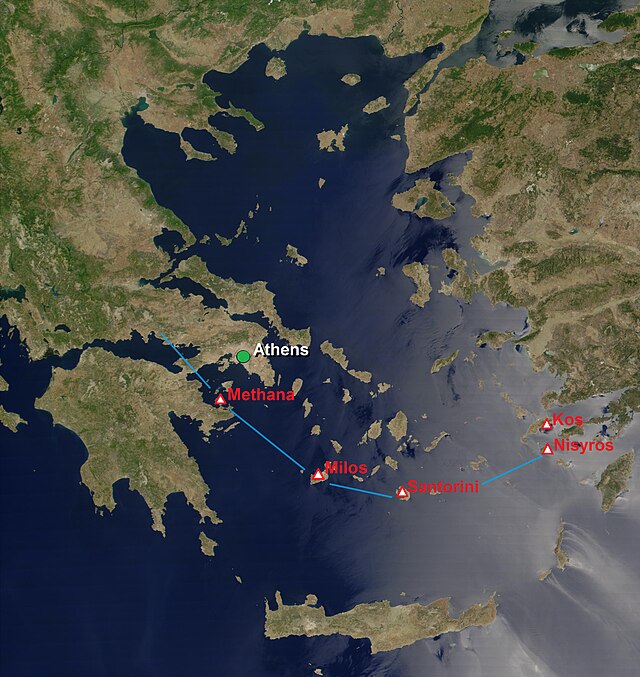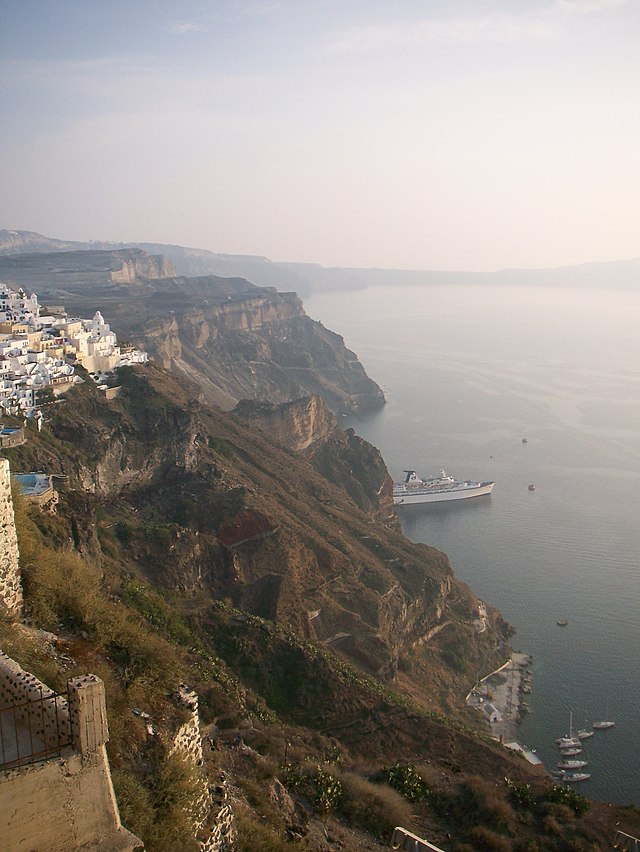Top Qs
Timeline
Chat
Perspective
Santorini caldera
Submerged caldera in the Aegean Sea From Wikipedia, the free encyclopedia
Remove ads
Santorini caldera is a large, mostly submerged caldera, located in the southern Aegean Sea, 120 kilometers north of Crete in Greece. Visible above water is the circular Santorini island group, consisting of Santorini (known as Thera in antiquity), the main island, Therasia and Aspronisi at the periphery, and the Kameni islands at the center. It has been designated a Decade Volcano.
Remove ads
Geography

The caldera measures about 12 by 7 km (7.5 by 4.3 mi), with 300 m (980 ft) high steep cliffs on three sides, and a maximum depth of 385 m (1,263 ft).[1]
There are two small volcanic islands at the center of the caldera, Nea ("New") Kameni and Palea ("Old") Kameni.
The main island, Santorini has an area of 75.8 km2 (29.3 sq mi), Therasia 9.3 km2 (3.6 sq mi), and the uninhabited islands of Nea Kameni 3.4 km2 (1.3 sq mi), Palea Kameni 0.5 km2 (0.19 sq mi) and Aspronisi 0.1 km2 (0.039 sq mi).
Santorini's high walls, draped by whitewashed villages, combined with a sunny climate and good observation conditions, have made it a magnet for volcanologists,[2] as well as a highlight of tourism in the Aegean.
Remove ads
Geology

The volcanic complex of Santorini is the most active part of the South Aegean Volcanic Arc, which includes the active volcanoes of Methana on the mainland of Greece, Milos, Santorini and Nisyros. It is formed by the subduction of the African tectonic plate underneath the Aegean subplate of the Eurasian tectonic plate, which occurs at a rate of up to 5 cm per year in a northeasterly direction. This subduction causes earthquakes at depths of 150–170 km.[3]
Non-volcanic rocks are exposed on Santorini at Mikro Profititis Ilias, Mesa Vouno, the Gavrillos ridge, Pirgos, Monolithos and the inner side of the caldera wall between Cape Plaka and Athinios.[4]
The Kameni islands at the center of the caldera are made of lava rocks.
Remove ads
Volcanology

The caldera of Santorini lies in the center of the Christiana-Santorini-Kolumbo volcanic field, which comprises the extinct Christiana Volcano, the Santorini Caldera, the polygenetic submarine Kolumbo Volcano, as well as the Kolumbo Volcanic Chain.[5] This volcanic lineament evolved during four main phases of volcanic activity, which initiated in the Pliocene from several local centers that only recently matured to form the vast Santorini edifice. The present-day caldera is composed of overlapping shield volcanoes, cut by at least four partially overlapping calderas, of which the oldest southern caldera was formed about 180,000 years ago. The subsequent Skaros caldera was created about 70,000 years ago, and the Cape Riva caldera about 21,000 years ago. The current caldera was formed about 3,600 years ago during the Minoan eruption.[6]
Palea Kameni and Nea Kameni were formed as a result of multiple, initially submarine, smaller eruptions at the center of the caldera.[7]
Eruptive history
Summarize
Perspective
Following is a list of the major eruptive events of Santorini beginning with the catastrophic Minoan eruption, as noted by the Smithsonian National Museum of Natural History's Global Volcanism Program:[6]
The huge Minoan eruption of Santorini in the 17th century BC may have inspired the legend of Atlantis.[8] It was rated 7 in the Smithsonian Global Volcanism Program's Volcanic Explosivity Index.[9]
Although dormant, Santorini is an active volcano. Numerous minor and medium-sized, mainly effusive, eruptions have built the dark-colored lava shields of Nea and Palea Kameni inside the caldera.
Their last eruption was in 1950, and now only fumarolic activity, primarily inside the recently active craters, takes place.[2] GPS instruments registered renewed deformation around the caldera in 2011 and 2012.[10]
Remove ads
Current unrest
Summarize
Perspective

In July 2024, Santorini entered a new phase of volcanic unrest. Starting in mid-summer of 2024, seismic activity increased significantly. The most intense volcano-tectonic seismic sequence occurred in the broader Anydros islet area, ~30 km to the northeast of Santorini since late January 2025. However, low-seismicity intra-caldera unrest since early July 2024 also occurred.[11]
Starting in the summer of 2024, slow deformation was recorded inside the Santorini Caldera. From 27 January – 24 February 2025, rapid inflation was observed with up to 7 mm/d moving vertically and westward. GNSS station and satellite InSar measurements also confirmed uplift was ongoing.[12] The intense seismic activity led to the evacuation of 11,000 people from the island. While authorities closed schools and warned against large indoor gatherings, Prime Minister Kyriakos Mitsotakis urged residents to remain calm.[13][14][15][16]
Another study interpreted the unrest as a time-evolving system that transitioned from a fluid-influenced swarm into a more regular tectonic sequence. The study used a manually revised public catalog, anomaly detection, and statistical modeling of time-dependent seismicity quantify diagnostic changes in event rate, magnitude–frequency behavior (b-value), and spatiotemporal clustering. They identify four stages:
- (1) an initial, volcano-driven phase beginning in summer 2024 with slightly accelerating moment release and growing focus toward the Amorgos area
- (2) A progressive onset in January 2025 marked by stronger clustering, a nearly steady b-value, and rapidly increasing magnitude variability was captured.
- (3) A short, intense and chaotic episode in early February 2025, when those metrics signal peak irregularity
- (4) a post-crisis interval in which the statistics reorganize toward a more regular, tectonic-like pattern with aftershock-style behavior.
The study argues that these quantitative precursory and evolutionary patterns are operationally useful for observatories: tracking shifts in clustering, b-value stability (consistency of the b-value over time and space, which is not always stable and is influenced by factors like stress, fluids, and geological structure.), and variability/entropy can help flag when a Santorini–Amorgos-type crisis is tipping from a fluids-affected swarm into a fault-controlled one, with implications for short-term hazard communication during future unrest in the area.[17]
On June 15, 2025, a new seismic swarm was detected under Santorini. These earthquakes where small and a continuation of the seismic crisis that began in the summer of 2024. The earthquakes were mostly smaller than magnitude 3, and clustered at depths between 5-20 km along the SW-NE oriented tectonic Kameni line, which has been the main source of magma ascent at the volcano over the past few hundred thousand years.[18]
Remove ads
IUGS geological heritage site
In respect of it being 'one of the largest calderas in the Mediterranean Sea formed by Plinian eruptions in a volcanic arc tectonic framework', the International Union of Geological Sciences (IUGS) included 'The Quaternary Santorini Caldera' in its assemblage of 100 'geological heritage sites' around the world in a listing published in October 2022. The organisation defines an IUGS Geological Heritage Site as 'a key place with geological elements and/or processes of international scientific relevance, used as a reference, and/or with a substantial contribution to the development of geological sciences through history.'[19]
Remove ads
References
Wikiwand - on
Seamless Wikipedia browsing. On steroids.
Remove ads


